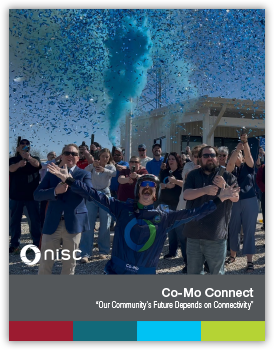Co-Mo Electric Cooperative was established in 1939, energizing its first section of line on Christmas Eve. Headquartered in Tipton, Missouri, it serves 33,530 meters in nine central Missouri counties. A majority of its members live in rural areas around small towns, as well as seasonal communities near the Lake of the Ozarks. Their system includes 4,100 miles of electrical line with an average density of eight meters per mile.
Business Drivers of Broadband Investment
In 2010, Co-Mo’s board and leadership were faced with a clear and growing challenge: rural communities were being left behind in the digital age. While high-speed internet was becoming essential for education, healthcare, business and daily life, most major internet service providers didn’t see rural Missouri as a profitable area to serve. As a result, members were stuck with slow or nonexistent internet options, creating a significant technological gap between urban and rural areas.
“Our leadership knew something had to be done,” said Barbie Petree, Co-Mo’s Information Technology Software Program Manager. “They recognized that high-speed internet wasn’t just a convenience, it was a necessity for the growth and economic development of our region. They understood that without reliable internet, our communities would struggle to keep pace and thrive in an increasingly connected world.”
Project Overview
 |
| Click here to download |
Co-Mo applied for government funding to help build a fiber network but was unsuccessful. However, as part of the grant funding process, staff collected numerous letters of support from members stating many compelling reasons the project was important.
“After reading those letters and hearing members speak at our public meetings, we knew the project needed to be built,” said Co-Mo CEO Aaron Bradshaw. “We needed to take a leap of faith.”
In a move that was both bold and visionary, the board of directors made the decision to move forward with a self-funded project.
“It was a difficult call but one that reflected a commitment to our members and their future,” Bradshaw said. “By choosing to launch a fiber-to-home project on their own, the board demonstrated true cooperative leadership. They understood the long-term benefits of investing in broadband and were willing to take the risk to ensure our members had the same opportunities as those in more urban areas.”
After researching the project’s feasibility, the Co-Mo Connect pilot project was launched, consisting of 500 member subscribers. The first home was connected on Dec. 24, 2011 – the same day the first electric member was connected 72 years earlier.
The pilot was a success, and in 2012, Co-Mo’s board and senior management developed a phased approach, splitting its service territory into four phases to continue construction of the project. Leadership required each phase to be successful before voting to approve the next phase. Construction for Phase 1 began in 2013, and the cooperative’s territory was fully built out in early 2017.
At the same time, Co-Mo also began a separate fiber construction project for non-members in underserved communities. They hired separate crews so the member project wouldn’t be negatively impacted, and the non-member project added revenue to assist with overall costs.
After the rapid growth of the initial project, Co-Mo began focusing on stability and steady growth. The electric cooperative and fiber project were rebranded into one company that now consists of 4,331 miles of fiber and reached 35,000 subscribers in March 2025.
Challenges and Surprises
Because Co-Mo was one of the earlier broadband adopters, it had to take a non-traditional approach with software deployments to ensure its customers wouldn’t require separate electric and broadband accounts. As a result, Co-Mo and its technology partner, National Information Solutions Cooperative (NISC), had to think outside the box. Co-Mo worked closely with NISC to advise what functionality was needed, and NISC began working on an application that would ultimately become iVUE Connect, a cloud-based, multi-industry enterprise solution.
Other challenges and surprises resulted in valuable lessons, including the importance of Geographic Information Systems (GIS), redundancy and managing subscriber and employee expectations, as well as realizing that the cheapest solution is not always the best.
Why is this Case Study Important?
Providing broadband services to the rural areas Co-Mo serves has dramatically improved quality of life.
“When we first started bringing broadband services to the area, it wasn’t just exciting, it was life changing,” Bradshaw said. “Chambers of Commerce began seeing businesses growing and thriving because of the opportunities high-speed internet created. There has also been increased interest in real estate, and we’re finding that today, high-speed internet is just as important as a house’s school district.”
“Our mission is to improve the quality of life for the region we serve,” Petree said. “We know the necessity of high-speed internet service, and we’re passionate about helping provide it to the communities we serve. Our future will not be behind the larger communities because of our connectivity.”
